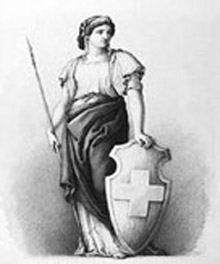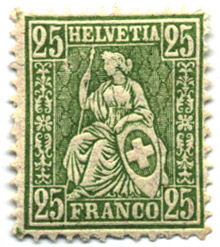Гельвеция


Гельвеция (Helvetia), латинское название северо-западной части современной Швейцарии (от населявших её в древности гельветов). Гельвеция - это женский символ-воплощение Швейцарии.
Helvetia is the Roman name for an ancient region of central Europe occupying a plateau between the Alps and the Jura Mountains. Helvetia corresponded roughly to the western part of modern Switzerland, and the name is still used poetically.
In the first century BC, a Celtic group known as the Helvetii migrated from Southern Germany to Switzerland. Eventually, they came up against the Romans. They were pushed back into Switzerland by Caesar's army in 58 BC. The Roman Empire founded its province of Helvetia in current Switzerland in 15 BC.
Helvetia was a peaceful and prosperous region for many years. Then, in AD 260, the Germans invaded and the Romans retreated. Helvetia passed hands between the Franks and the Germans for many years until the Swiss Confederation was founded on August 1, 1291.
Switzerland continues to use the name in its Latin form when it is inappropriate or inconvenient to use any or all of its four official languages. Thus, the name appears on postage stamps, coins and other uses; the full name, Confœderatio Helvetica, is abbreviated for uses such as the ccTLD, .ch.
Notably, translations of the term Helvetia still serve as the name for Switzerland in languages such as Irish, in which the country is known as An Elvéis, and Greek, in which it is known as Ελβετία (Elvetia).
Helvetia is the female personification of Switzerland. Sometimes called the mother of the Swiss nation, she is typically pictured in a flowing gown, with a spear and a shield emblazoned with the Swiss flag, and commonly with braided hair, commonly with a wreath as a symbol of Confederation.
Helvetia is the Roman name for an ancient region of central Europe occupying a plateau between the Alps and the Jura Mountains. Helvetia corresponded roughly to the western part of modern Switzerland, and the name is still used poetically.
In the first century BC, a Celtic group known as the Helvetii migrated from Southern Germany to Switzerland. Eventually, they came up against the Romans. They were pushed back into Switzerland by Caesar's army in 58 BC. The Roman Empire founded its province of Helvetia in current Switzerland in 15 BC.
Helvetia was a peaceful and prosperous region for many years. Then, in AD 260, the Germans invaded and the Romans retreated. Helvetia passed hands between the Franks and the Germans for many years until the Swiss Confederation was founded on August 1, 1291.
Switzerland continues to use the name in its Latin form when it is inappropriate or inconvenient to use any or all of its four official languages. Thus, the name appears on postage stamps, coins and other uses; the full name, Confœderatio Helvetica, is abbreviated for uses such as the ccTLD, .ch.
Notably, translations of the term Helvetia still serve as the name for Switzerland in languages such as Irish, in which the country is known as An Elvéis, and Greek, in which it is known as Ελβετία (Elvetia).
Helvetia is the female personification of Switzerland. Sometimes called the mother of the Swiss nation, she is typically pictured in a flowing gown, with a spear and a shield emblazoned with the Swiss flag, and commonly with braided hair, commonly with a wreath as a symbol of Confederation.